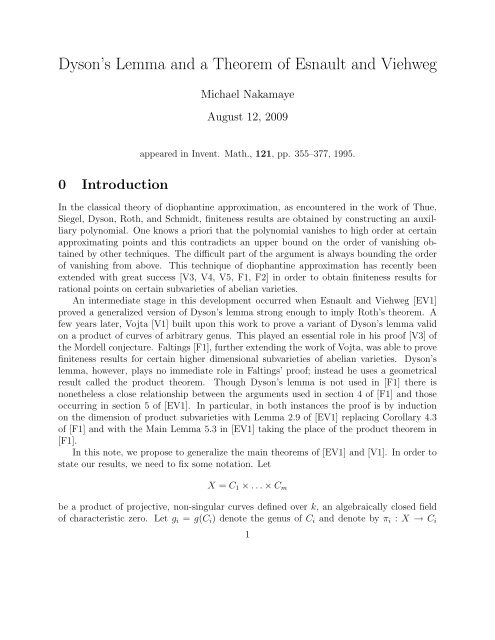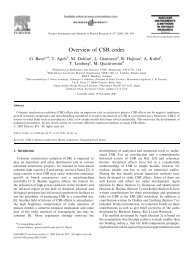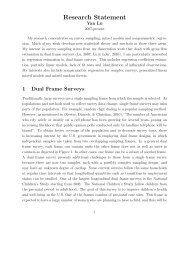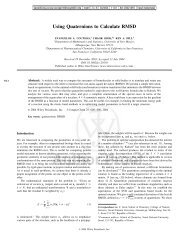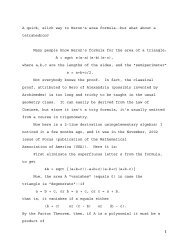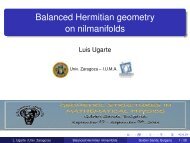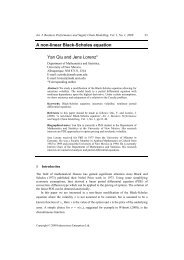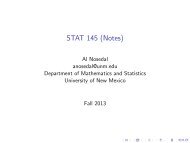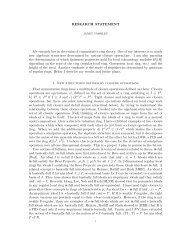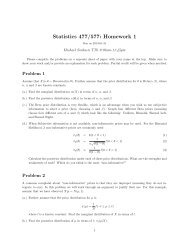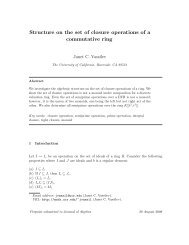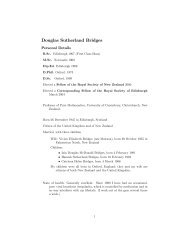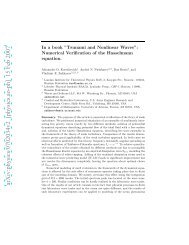Dyson's Lemma and a Theorem of Esnault and Viehweg
Dyson's Lemma and a Theorem of Esnault and Viehweg
Dyson's Lemma and a Theorem of Esnault and Viehweg
Create successful ePaper yourself
Turn your PDF publications into a flip-book with our unique Google optimized e-Paper software.
Dyson’s <strong>Lemma</strong> <strong>and</strong> a <strong>Theorem</strong> <strong>of</strong> <strong>Esnault</strong> <strong>and</strong> <strong>Viehweg</strong>Michael NakamayeAugust 12, 2009appeared in Invent. Math., 121, pp. 355–377, 1995.0 IntroductionIn the classical theory <strong>of</strong> diophantine approximation, as encountered in the work <strong>of</strong> Thue,Siegel, Dyson, Roth, <strong>and</strong> Schmidt, finiteness results are obtained by constructing an auxilliarypolynomial. One knows a priori that the polynomial vanishes to high order at certainapproximating points <strong>and</strong> this contradicts an upper bound on the order <strong>of</strong> vanishing obtainedby other techniques. The difficult part <strong>of</strong> the argument is always bounding the order<strong>of</strong> vanishing from above. This technique <strong>of</strong> diophantine approximation has recently beenextended with great success [V3, V4, V5, F1, F2] in order to obtain finiteness results forrational points on certain subvarieties <strong>of</strong> abelian varieties.An intermediate stage in this development occurred when <strong>Esnault</strong> <strong>and</strong> <strong>Viehweg</strong> [EV1]proved a generalized version <strong>of</strong> Dyson’s lemma strong enough to imply Roth’s theorem. Afew years later, Vojta [V1] built upon this work to prove a variant <strong>of</strong> Dyson’s lemma validon a product <strong>of</strong> curves <strong>of</strong> arbitrary genus. This played an essential role in his pro<strong>of</strong> [V3] <strong>of</strong>the Mordell conjecture. Faltings [F1], further extending the work <strong>of</strong> Vojta, was able to provefiniteness results for certain higher dimensional subvarieties <strong>of</strong> abelian varieties. Dyson’slemma, however, plays no immediate role in Faltings’ pro<strong>of</strong>; instead he uses a geometricalresult called the product theorem. Though Dyson’s lemma is not used in [F1] there isnonetheless a close relationship between the arguments used in section 4 <strong>of</strong> [F1] <strong>and</strong> thoseoccurring in section 5 <strong>of</strong> [EV1]. In particular, in both instances the pro<strong>of</strong> is by inductionon the dimension <strong>of</strong> product subvarieties with <strong>Lemma</strong> 2.9 <strong>of</strong> [EV1] replacing Corollary 4.3<strong>of</strong> [F1] <strong>and</strong> with the Main <strong>Lemma</strong> 5.3 in [EV1] taking the place <strong>of</strong> the product theorem in[F1].In this note, we propose to generalize the main theorems <strong>of</strong> [EV1] <strong>and</strong> [V1]. In order tostate our results, we need to fix some notation. LetX = C 1 × . . . × C mbe a product <strong>of</strong> projective, non-singular curves defined over k, an algebraically closed field<strong>of</strong> characteristic zero. Let g i = g(C i ) denote the genus <strong>of</strong> C i <strong>and</strong> denote by π i : X → C i1
the projection to the i th factor. Let L be an invertible sheaf on X <strong>and</strong> fix a global sections ∈ H 0 (X, L). We first need to define, following [V1] Definition 0.2 <strong>and</strong> [EV1] Definition0.2, the index <strong>of</strong> s at a closed point <strong>of</strong> X.Definition 0.1 Let s ∈ H 0 (X, L) <strong>and</strong> let ζ ∈ X be a closed point. Let z j be a localparameter in O πj (ζ),C j. We also denote by z j the induced function on X. Then taking a localtrivialization <strong>of</strong> L, s has a power series expansion about ζs = ∑ α≥0b α z α 11 · . . . · z αmm , α = (α 1, . . .,α m ).Let a = (a 1 , . . .,a m ) be an m–tuple <strong>of</strong> non–negative real numbers. Then the index ind a (ζ, s)with respect to a <strong>of</strong> s at ζ is defined as follows:{ ∣ m}∑ ∣∣∣∣ind a (ζ, s) = min a i α i b α ≠ 0 .i=1It is clear that ind a (ζ, s) does not depend on the choice <strong>of</strong> the local trivialization <strong>of</strong> L or onthe choice <strong>of</strong> local parameters {z j }.Next we define a set <strong>of</strong> invariants <strong>of</strong> the sheaf L which measure the “degree” <strong>of</strong> L in thedifferent directions.Definition 0.2 Let L be an invertible sheaf on X <strong>and</strong> choose a closed point P i ∈ C i forall i. We define the intersection numberd i (L) := L · [π ∗ 1O C1 (P 1 ) · . . . · π ∗ i−1O Ci−1 (P i−1 ) · π ∗ i+1O Ci+1 (P i+1 ) · . . . · π ∗ mO Cm (P m ) ] .We will usually abbreviate d i = d i (L) <strong>and</strong> d = (d 1 , . . .,d m ). We also defineδ i = δ i (L) :=m∑j=i+1d j <strong>and</strong> δ = δ(L) := (δ 1 , . . .,δ m ).Note that if D is a Q–Cartier divisor on X, d(D) still makes since the invariant d is definedin terms <strong>of</strong> intersection numbers. Finally for any divisors D i on C i with deg D i = d i writem⊗F d := πi ∗ O C i(D i ).i=1Of course F d depends on the choice <strong>of</strong> the divisors D i but as we will only be concerned withits numerical equivalence class we abuse notation <strong>and</strong> suppress this dependence.Having defined the index, we need to define an associated volume which measures howmany linear conditions are imposed on a function f ∈ O ζ,X in order to satisfy ind a (ζ, f) ≥ t.We copy [EV1] Definition 0.2:Definition 0.3 Let I n = {(ξ ν ) ∈ R n ; 0 ≤ ξ ν ≤ 1} <strong>and</strong> let{}m∑I(d, a, t) = (ξ ν ) ∈ I n ; d ν ξ ν a ν ≤ t .2ν=1
Then define∫Vol(d, a, t) :=I(d,a,t)dξ 1 ∧ . . . ∧ dξ m .One sees that Vol(d, a, t) is the asymptotic proportion <strong>of</strong> total conditions imposed on apolynomial P <strong>of</strong> degree ≤ (nd 1 , . . .,nd m ) in order to have index ≥ nt at a fixed point in X(for n → ∞). We can now state the main theorem <strong>of</strong> this paper:<strong>Theorem</strong> 0.4 Let S = {ζ 1 , . . .,ζ M } ⊂ X be a finite subset such that card(S) = card[π j (S)]for all j. LetM i = max{2g i − 2 + M, 0}.Let D be a numerically effective Q–Cartier divisor with d(D) ≤ d = d(L) such that thereexists N > 0 for which [ (L(D) ) ]h 0 ⊗ F⊗−1 ⊗Nd ≠ 0.Let P i ∈ C i be a fixed closed point. Let s ∈ H 0 (X, L) <strong>and</strong> suppose t i = ind a (ζ i , s). Then(∏ m)∑ Md i Vol(d, a, t i ) ≤ 1 [L(D) ⊗i=1 i=1m!( m−1 ⊗i=1π ∗ i O Ci (δ i M i · P i ))] top,where the exponent top means the highest power <strong>of</strong> self-intersection.In qualitative language, <strong>Theorem</strong> 0.4 states that for n large the linear conditions imposedon a section s ∈ H 0 (X, L ⊗n ) in order to satisfy ind a (ζ i , s) ≥ t i are “almost independent.”The failure for the conditions to be independent is measured by the perturbation termO X (D) ⊗ m−1i=1 πi ∗ O Ci (δ i M i · P i ) <strong>and</strong> the perturbation is “small” when for example D is nottoo positive <strong>and</strong> d i ≫ d i+1 for all i. To see this consider [EV1] <strong>Theorem</strong> 0.4:Corollary 0.5 (<strong>Esnault</strong>–<strong>Viehweg</strong>) With notation as in <strong>Theorem</strong> 0.4 suppose X = (P 1 ) mis a product <strong>of</strong> m projective lines <strong>and</strong> L = ⊗ mi=1 π ∗ i O P 1(d i). Letting M ′ = max{M − 2, 0},⎛M∑m−1 ∏Vol(d, a, t i ) ≤i=1i=1⎝1 + M ′m ∑j=i+1⎞d j⎠.d iFor the pro<strong>of</strong> <strong>of</strong> Corollary 0.5, note that when X is a product <strong>of</strong> projective lines Definition0.2 implies that L ≃ F d <strong>and</strong> consequently one can take D = 0 in <strong>Theorem</strong> 0.4. A slightlyweaker version <strong>of</strong> [V1] <strong>Theorem</strong> 0.4 also follows from <strong>Theorem</strong> 0.4 or rather from its pro<strong>of</strong>:Corollary 0.6 (Vojta) Let X = C 1 ×C 2 be a product <strong>of</strong> two smooth projective curves. Lets ∈ H 0 (X, L) <strong>and</strong> let e denote the maximum multiplicity <strong>of</strong> all non-fibral components <strong>of</strong> thezero scheme Z(s). ThenM∑Vol(d, a, t i ) ≤ L · L + eM 1′ .2d 1 d 2 d 1 d 2i=13
Corollary 0.6 will follow readily from the general method used to tackle <strong>Theorem</strong> 0.4.Vojta’s result [V1] is better by a factor <strong>of</strong> two on the second term on the right; for an analysis<strong>of</strong> this situation, see [EV1] §10.The drawback with <strong>Theorem</strong> 0.4 is the dependence on the Q-divisor D. It is not clear,given an arbitrary line bundle L on X, how to compute the “best” or minimal D. In someinstances, however, such as the line bundles used by Faltings [F1] <strong>and</strong> Vojta [V4], one hascontrol over D <strong>and</strong> it would perhaps be interesting to carry out the pro<strong>of</strong> <strong>of</strong> the Mordellconjecture in [V4] using <strong>Theorem</strong> 0.4.Our pro<strong>of</strong> <strong>of</strong> <strong>Theorem</strong> 0.4 combines ideas <strong>of</strong> <strong>Esnault</strong> <strong>and</strong> <strong>Viehweg</strong> [EV1], Vojta [V1], <strong>and</strong>Faltings [F1]. In broad outline, the pro<strong>of</strong> follows [EV1] §1 – §5 very closely. In particular,we derive <strong>Theorem</strong> 0.4 from the positivity <strong>of</strong> a certain sheaf constructed from L <strong>and</strong> thepositivity statement is shown by induction on the dimension <strong>of</strong> product subvarieties. But ourconstruction is more direct in that instead <strong>of</strong> working with weak positivity <strong>of</strong> direct imagesheaves we take “derivatives” <strong>of</strong> the section s <strong>and</strong> use a result resembling Faltings’ Product<strong>Theorem</strong>. Most <strong>of</strong> the results <strong>of</strong> [EV1] §1 – §5 carry over to the more general setting withlittle or no modification. An exception, however, is [EV1] §2 where the pro<strong>of</strong>s, relying onexplicit constructions <strong>of</strong> multihomogeneous polynomials, need to be replaced with somewhatmore abstract methods. In particular, the Q–divisor D in the statement <strong>of</strong> <strong>Theorem</strong> 0.4 isnecessary in order to derive the analogue <strong>of</strong> [EV1] <strong>Lemma</strong> 2.9 (ii).In simplifying the logic <strong>of</strong> the pro<strong>of</strong>, we hope to make the more technical sections <strong>of</strong> [EV1]available to a wider audience. A fundamental insight <strong>of</strong> [EV1], exploited most fully by Vojta[V1, V2, V3], is that lower bounds on vanishing come from arithmetic conditions while theupper bounds are purely geometric. The full significance <strong>of</strong> the methods <strong>of</strong> weakly positivesheaves <strong>and</strong> their relation to diophantine problems have not been completely understood. Inparticular, one might hope to use weak positivity in order to give a more “geometric” pro<strong>of</strong><strong>of</strong> the results in [F2].The stucture <strong>of</strong> the paper is as follows. In order to prove <strong>Theorem</strong> 0.4 it suffices to showthat a certain sheaf is positive; in practice, this means producing more sections s ′ ∈ H 0 (X, L)with index at least t i at ζ i . If there were enough such sections to generate L <strong>of</strong>f <strong>of</strong> the pointsζ i , <strong>Theorem</strong> 0.4 would follow immediately. In full generality, however, s might be the onlyglobal section <strong>of</strong> L with index at least t i at ζ i . In order to produce more sections, we takederivatives <strong>of</strong> s. This is straightforward in the case when X is a product <strong>of</strong> projective linesbut in general more care is necessary <strong>and</strong> we introduce the necessary definitions in section 1.In section 2 we show, following [EV1] §5, how to deduce <strong>Theorem</strong> 0.4 from the positivity <strong>of</strong>an invertible sheaf. The positivity result is shown in two steps, occupying sections 3 <strong>and</strong> 4respectively. First one shows that after taking a “bounded” number <strong>of</strong> derivatives <strong>of</strong> s, theextra sections generate except on a finite union <strong>of</strong> proper product subvarieties. This allowsone to induct on the dimension <strong>of</strong> X <strong>and</strong> the inductive step is carried out in section 4. Atthe end <strong>of</strong> section 4 we show how to derive Vojta’s result [V1] with the techniques developedto prove <strong>Theorem</strong> 0.4.Acknowledgments.This paper forms part <strong>of</strong> my Ph.D. thesis <strong>and</strong> it is a pleasure to thank my advisor Serge4
Lang for his encouragement <strong>and</strong> guidance. I would also like to thank H. <strong>Esnault</strong>, E. <strong>Viehweg</strong>,P. Vojta, <strong>and</strong> especially R. Lazarsfeld for many stimulating conversations without which thiswork could not have been completed.Notation <strong>and</strong> Conventions• On a variety X, a Q-Cartier divisor is an element <strong>of</strong> Div(X) ⊗Q where Div(X) is thegroup <strong>of</strong> Cartier divisors on X.• A Q-Cartier divisor on X is said to be numerically effective or nef for short if D·C ≥ 0for all integral curves C ⊂ X (<strong>of</strong> course the product D·C is just the intersection producton Cartier divisors <strong>and</strong> is extended by linearity to Div(X) ⊗ Q).• If F is a coherent sheaf on X then h i (X, F) = dim H i (X, F).• When X is smooth K X denotes the canonical bundle on X.• If f : X → Y is a morphism <strong>of</strong> schemes <strong>and</strong> I is an ideal sheaf on Y , then we writef −1 I for the inverse image ideal sheaf on X (cf. [H] p. 163).1 PreliminariesAs in the introduction, fix once <strong>and</strong> for all a product <strong>of</strong> smooth projective curvesX = C 1 × . . . × C m .An important special case (the case h<strong>and</strong>led by [EV1]), which we will consider in some depthas it has the advantage <strong>of</strong> being very concrete, is that <strong>of</strong> a product <strong>of</strong> m projective lines:LetP = P 1 1 × . . . × P1 m .R = k[X 1 , Y 1 , . . .,X m , Y m ]denote the projective coordinate ring <strong>of</strong> P. If I ⊂ R is a homogeneous ideal, then denoteby V (I) ⊂ P the associated subscheme <strong>and</strong> by Z(I) = V (I) red the underlying point set. Wewill <strong>of</strong>ten work on a fixed product affine open subset A = ∏ mi=1 A 1 i ⊂ P where each A 1 i isgiven by, say, Y i ≠ 0. Let ξ i denote the affine coordinate on A 1 i . For an m–tuple <strong>of</strong> integersd = (d 1 , . . .,d m ) writem⊗O P (d) = πi ∗ O P 1(d i).ii=1In what follows we will not distinguish between a global section P ∈ H 0 [O P (d)] <strong>and</strong> theassociated polynomial in several variables P A .5
Dyson’s <strong>Lemma</strong> can be viewed as a statement about certain derivatives <strong>of</strong> sections <strong>of</strong> linebundles. In the case <strong>of</strong> P it is clear how to take derivatives <strong>of</strong> the polynomial P(ξ 1 , . . .,ξ m ).To fix notation, let D i = ∂/∂ξ i <strong>and</strong>D α =m∏i=1D α ii , for an m–tuple α = (α 1 , . . .,α m ).It will be helpful in some instances not only to take derivatives locally on A but also globally.If s ∈ H 0 [P, O P (d)] <strong>and</strong> Z ⊂ Z(s) is some integral subvariety contained in the zero scheme<strong>of</strong> s, then one can define D i (s) as a meromorphic section <strong>of</strong> O P (d) ⊗ πi ∗K P 1 |Z: locally, oniA say, D i (s) is given by taking the derivative in the naive sense <strong>of</strong> polynomials. In practice,however, it will be necessary to have an everywhere regular section <strong>of</strong> O P (d) ⊗πi ∗K P 1 |Z <strong>and</strong>iso a slight modification will be necessary; we will describe this modification at the end <strong>of</strong>the section.The notion <strong>of</strong> partial derivatives can now be extended to products <strong>of</strong> curves <strong>of</strong> arbitrarygenus (cf. [F1] p. 560 <strong>and</strong> p. 566 for a more general treatment). Fix projective embeddingsC i ֒→ P n i<strong>and</strong> generic projections p i : C i → P 1 . Then one can pull back the derivation onP 1 via p i , with poles along the ramification divisor R <strong>of</strong> p i <strong>and</strong> so obtain:Definition 1.1 Let s ∈ H 0 (X, L) <strong>and</strong> suppose Z ⊂ Z(s). Then D i (s)|Z is the meromorphicsection <strong>of</strong> L[π ∗ i (p ∗ iK P 1 +R)]|Z ≃ L(π ∗ i K Ci )|Z obtained locally by pulling back the derivationon O P 1 via the composition p i · π i . Higher order derivatives are defined analogously so forα = (α 1 , . . .,α m )( m)∣D α ∑ ∣∣∣∣(s) is a meromorphic section <strong>of</strong> L α i πi ∗ K C iZi=iprovided all partial derivatives D β (s) with β < α vanish identically along Z.Having defined derivatives we can reformulate Definition 0.1. For s ∈ H 0 (X, L) <strong>and</strong> aclosed point ζ ∈ X we have{ m∣ }∑ ∣∣∣∣ m∏ind a (ζ, s) = min a i α i D α (s)|ζ ≠ 0 where D α = D α ii .i=1i=1When X = P <strong>and</strong> L = O P (d), ind a (ζ, s) ≥ t if <strong>and</strong> only if s has a zero <strong>of</strong> type (a, t) at ζ inthe language <strong>of</strong> [EV1] Definition 0.2.Fix a finite set <strong>of</strong> points S = {ζ i } M i=1 ⊂ X <strong>and</strong> an m–tuple a = (a 1 , . . .,a m ) as inDefinition 0.1. We want to define an ideal sheaf I(s) on X so that s ∈ H 0 [X, L ⊗ I(s)] <strong>and</strong>so that I(s) characterizes the index <strong>of</strong> s at the points ζ i ∈ S. For a fixed point ζ ∈ X <strong>and</strong>t ∈ R + , define an ideal sheaf I ζ,d,t as follows: write ζ j = π j (ζ) <strong>and</strong> consider the local ringm⊗O ζ,X ≃ O ζj ,C j.j=16
Let z j be a local parameter in O ζj ,C jso that {z 1 , . . .,z m } form a regular system <strong>of</strong> parametersfor O ζ,X . First we define an ideal I ζ,d,t ⊂ O ζ,X :⎛⎞m∏I ζ,d,t := ⎝M α = z α jjα j ≤ d j for all j <strong>and</strong> ind a (ζ, M α ) ≥ t⎠.∣j=1The definition <strong>of</strong> I ζ,d,t does not depend on the choice <strong>of</strong> local parameters {z 1 , . . .,z m }. AlthoughI ζ,d,t does depend on the choice <strong>of</strong> a used to define the index, we omit this from thenotation as a will be fixed throughout. Choose a small product affine open subsetm∏U = U j = Specj=1m⊗A jj=1with z i ∈ A i for all i so that the only zero <strong>of</strong> z i in U i is ζ i . We will continue to denote by I ζ,d,tthe ideal sheaf on U associated to I ζ,d,t . Letting f : U ֒→ X denote the natural inclusion,defineI ζ,d,t := f ∗ I ζ,d,t ∩ O X (cf. [EV1] 2.2).It is not difficult to check that the definition does not depend on the choice <strong>of</strong> U.Definition 1.2 Fix a set S ⊂ X as in <strong>Theorem</strong> 0.4 <strong>and</strong> let t i = ind a (ζ i , s). ThenM⋂I(s) := I ζi ,d,t i.i=1It is clear from the definition that s ∈ H 0 [X, L ⊗ I(s)]. In the special case where X = P<strong>and</strong> L = O P (d), the sheaf I(s) corresponds with L ′ as defined in [EV1] 2.6. Note also (cf.[EV1] 2.3) that the Riemann–Roch theorem for curves implies thatI ζ,nd,nt ⊗ F ⊗nd is generated by global sections for all n ≫ 0.There is some subtlety here because when t = m, this statement is false for an arbitrarychoice <strong>of</strong> divisors D i on C i in the definition <strong>of</strong> F d . The problem is not serious, however,because one can always add the Q–Cartier divisor ǫ ∑ mi=1 π ∗ i D i to O X (D) <strong>and</strong> F d ; one canthen verify that taking the limit as ǫ → 0 yields <strong>Theorem</strong> 0.4. We will frequently encounterthis procedure. In any case, we will always have t < m so this is not important.We will need an auxilliary sheaf M(L, S), depending on L <strong>and</strong> the finite subset S ⊂ X.This will be used to make adjustments after taking derivatives <strong>of</strong> the section s ∈ H 0 (X, L).WriteS i = π i (S) = {ζ i1 , . . ., ζ iNi }.Also if g(C i ) = 0 <strong>and</strong> N i = 1 let S i ′ = {ζ i1, ζ i2 } for a general point ζ i2 ∈ C i . Otherwise letS i ′ = S i. Finally set{maxN i ′ {Ni , 2}, if g(C=i ) = 0,N i , otherwise.7
Thus N ′ i = card(S′ i ).Definition 1.3 Given an invertible sheaf L on X, a finite subset S ⊂ X, <strong>and</strong> an m–tupleα = (α 1 , . . .,α m ), let⎛⎞N m⊗M(L, S, α) := πi∗ ∑i′⎝α i K Ci + α i ζ ij⎠i=1j=1We will abbreviate M(α) = M(L, S, α), the set S <strong>and</strong> the sheaf L being tacitly understood.Suppose Z ⊂ X is a subvariety for which D α (s)|Z is defined <strong>and</strong> let j : Z ֒→ X denotethe inclusion. The point <strong>of</strong> Definition 1.3 is that after adjusting D α (s) by M(α) not onlydoes D α (s) become an everywhere regular section but also one can write⎡⎛ ⎞⎤N m∑′⎣D α (s) + πi∗ ∑i⎝α i ζ ij⎠⎦Z ∈i=1 j=1 ∣ H0 [L ⊗ M(α) ⊗ j −1 I(s)]. (1.4)To see this, identify K Ci with some effective divisor if g(C i ) > 0 or with O P 1(−ζ i1 − ζ i2 ) incase g(C i ) = 0. This makes⎛ ⎞N m∑D α (s) + πi∗ ∑i′ ⎝α i ζ ij⎠Zi=1 j=1 ∣an everywhere regular section <strong>of</strong> L ⊗ M(α) <strong>and</strong> one can check locally that this is a section<strong>of</strong> H 0 [L ⊗ M(α) ⊗ j −1 I(s)].2 Reduction to a Positivity StatementIn this section we show how to reduce <strong>Theorem</strong> 0.4 to a positivity result. First note thatby replacing L with L ⊗n <strong>and</strong> s with s ⊗n we can assume without loss <strong>of</strong> generality thatN = 1 in the statement <strong>of</strong> <strong>Theorem</strong> 0.4. Choosing n sufficiently divisible will also guaranteethat [EV1] <strong>Lemma</strong> 1.9 holds. Also, it suffices to prove <strong>Theorem</strong> 0.4 for rational m–tuplesa = (a 1 , . . .,a m ) <strong>and</strong>, clearing denominators, one can assume that all a i are integers.<strong>Theorem</strong> 2.1 Let D <strong>and</strong> s ∈ H 0 (X, L) be as in the statement <strong>of</strong> <strong>Theorem</strong> 0.4. Letτ : ˜X → Xbe the blow-up <strong>of</strong> X along the ideal sheaf I(s) <strong>and</strong> let E denote the exceptional divisor.Recall δ = (δ 1 , . . .,δ m ) from Definition 0.2. Then τ ∗ [L(D) ⊗ M(δ)](−E) is nef.8
To show how <strong>Theorem</strong> 2.1 implies <strong>Theorem</strong> 0.4 we will need a few technical lemmas.The reader familiar with [EV1] can refer to [EV1] 5.11–5.12 <strong>and</strong> skip the rest <strong>of</strong> this sectionexcept for <strong>Lemma</strong> 2.2 which will be used later in §4.<strong>Lemma</strong> 2.2 ([EV1] <strong>Lemma</strong> 2.7) With S ⊂ X, s ∈ H 0 (X, L), <strong>and</strong> t i as in the statement <strong>of</strong><strong>Theorem</strong> 0.4, let ζ 1 , ζ 2 ∈ S be two points. Thenm∑a i d i ≥ t 1 + t 2 . (2.2.1)i=1Pro<strong>of</strong>: The pro<strong>of</strong> will be by induction on m <strong>and</strong> already gives a flavor <strong>of</strong> the inductivepart <strong>of</strong> the pro<strong>of</strong> <strong>of</strong> <strong>Theorem</strong> 2.1 in §4. Let V = π1 −1 [π 1 (ζ 1 )] <strong>and</strong> write Z(s) = Z(s ′ ) + aVfor s ′ ∈ H 0 (X, L ′ ) <strong>and</strong> V ⊄ supp[Z(s ′ )]. Replacing (s, L) by (s ′ , L ′ ) it is clear thatm∑a i d i ≥ t 1 + t 2 if <strong>and</strong> only ifi=1m∑a i d ′ i ≥ t′ 1 + t′ 2i=1because the change decreases both sides <strong>of</strong> (2.2.1) by exactly a · a 1 . So we can assume thats|V is a well defined non-zero section <strong>of</strong> L|V . Let ζ ′ i = π {2,...,m}(ζ i ) for i = 1, 2. It followsthat ind a (ζ ′ 1, s|V ) ≥ t 1 . Thus, <strong>Lemma</strong> 2.2 will be proven by the inductive hypothesis if wecan show thatind a (ζ ′ 2 , s|V ) ≥ t 2 − a 1 d 1 . (2.2.2)One can clearly assume that t 2 − a 1 d 1 > 0. So suppose (2.2.2) is false. Then there existsa differential operator D α withChoose α so thatD α (s|V )|ζ 2 ′ m ≠ 0, ∑a i α i < t 2 − a 1 d 1 .i=2(a) D β (s) vanishes identically along C 1 × ζ ′ 2 for β < α,(b) D α (s) does not vanish identically along C 1 × ζ 2 ′ ,m∑(c) a i α i < t 2 − a 1 d 1 .i=2Hence D α (s)|C 1 ×ζ ′ 2 gives a well defined non-zero global section <strong>of</strong> an invertible sheaf on C 1with degree ≤ d 1 . Thus one can find α 1 ≤ d 1 such thatD α 11 [Dα (s)] |ζ 2 ≠ 0<strong>and</strong> this contradicts the assumption that ind a (ζ 2 , s) ≥ t 2 .9
Corollary 2.3 ([EV1] <strong>Lemma</strong> 2.8) Let W i be the support <strong>of</strong> the subscheme defined by I ζi ,s.Then W i⋂ Wj is empty for all i ≠ j.Pro<strong>of</strong>: Corollary 2.3 is a straightforward consequence <strong>of</strong> <strong>Lemma</strong> 2.2 <strong>and</strong> is left as anexercise; the pro<strong>of</strong> in [EV1] <strong>Lemma</strong> 2.8 goes through unchanged as [EV1] <strong>Lemma</strong> 2.5 easilyextends to our situation.Since we have assumed N = 1, the assumptions in <strong>Theorem</strong> 0.4 imply that there is aneffective divisor Γ such thatO X (Γ) ≃ L(D) ⊗ Fd −1 .<strong>Lemma</strong> 2.4 The invertible sheaf O X (Γ) ⊗ M(δ) is nef.<strong>Lemma</strong> 2.4 will be proved at the end <strong>of</strong> §3; it is similar to the pro<strong>of</strong> <strong>of</strong> <strong>Theorem</strong> 2.1except that the inductive step is significantly simpler.<strong>Lemma</strong> 2.5 Let ζ ∈ X be a closed point <strong>and</strong> let Z ζ,n be the subscheme defined by I ⊗nζ,d,t fort = ind a (ζ, s). Thenh ( 0 X, Z ζ,n ⊗ [L(D) ⊗ M(δ)] ⊗n)limn→∞ n m ∏ m≥ Vol(d, a, t).i=1 d iPro<strong>of</strong>: By [EV1] <strong>Lemma</strong> 1.9 <strong>and</strong> the assumption made at the beginning <strong>of</strong> this sectionBy Definition 0.3 one obtains (cf. [EV1] 2.4)I ⊗nζ,d,t = I ζ,nd,nt⎛ ( )lim ⎝ h0 X, F ( )d⊗n − h0X, Fd ⊗n ⎞⊗ I ζ,nd,ntn→∞n m ∏ ⎠m= Vol(d, a, t).i=1 d iFrom the long exact cohomology sequence associated toone obtainsSince0 → I ζ,nd,nt ⊗ F ⊗nd→ F ⊗nd→ Z ζ,n ⊗ F ⊗nd → 0⎛ ( )lim ⎝ h0 X, Z ζ,n ⊗ Fd⊗n ⎞n→∞ n m ∏ ⎠m≥ Vol(d, a, t). (2.5.1)i=1 d i[L(D) ⊗ M(δ)] ⊗n ≃ [O X (Γ) ⊗ M(δ)] ⊗n ⊗ F ⊗nd .<strong>Lemma</strong> 2.5 now follows from (2.5.1) <strong>and</strong> <strong>Lemma</strong> 2.4 by adding ǫA to L where A is an ampledivisor on X <strong>and</strong> taking the limit as ǫ → 0.Pro<strong>of</strong> <strong>of</strong> <strong>Theorem</strong> 0.4 from <strong>Theorem</strong> 2.1: first we need to show, in the language <strong>of</strong> [EV1]Definition 3.3, that the ideal sheaf I(s) is full. This can be done as in [EV1] §3, using the10
covering construction <strong>of</strong> [V1] <strong>Lemma</strong> 3.1 instead <strong>of</strong> the simple ramified cover <strong>of</strong> P used in[EV1] 3.9. We will not reproduce the argument here. The rest <strong>of</strong> the argument is purelycohomological <strong>and</strong> the fact that I(s) is full will be used in order to apply the Leray spectralsequence. The argument is given in [EV1] 5.11–5.12.Let f : Y → ˜X be a desingularization <strong>of</strong> ˜X <strong>and</strong> let g = τ · f : Y → X. LetO Y (−F) = Im : g ∗ I(s) → O Y .Then O Y (−F) ≃ f ∗ O ˜X(−E) <strong>and</strong> so by <strong>Theorem</strong> 2.1, g ∗ [L(D) ⊗ M(δ)](−F) is nef. Henceby [EV1] Corollary 4.7, it follows that there exists a polynomial P(n) <strong>of</strong> degree ≤ m − 1such thath 1 ( X, [g ∗ [L(D) ⊗ M(δ)](−F)] ⊗n) ≤ P(n) for all n ≥ 0.Using the fact that I(s) is full <strong>and</strong> the Leray spectral sequence it follows thath 1 ( X, [L(D) ⊗ M(δ) ⊗ I(s)] ⊗n) ≤ P(n) for all n ≥ 0. (2.6)Suppose Z n ⊂ X is the subscheme defined by the ideal sheaf I(s) ⊗n <strong>and</strong> consider the exactsequence0 → [L(D) ⊗ M(δ) ⊗ I(s)] ⊗n → [L(D) ⊗ M(δ)] ⊗n → Z n ⊗ [L(D) ⊗ M(δ)] ⊗n → 0. (2.7)By <strong>Theorem</strong> 2.1, τ ∗ [L(D) ⊗ M(δ)](−E) is nef on ˜X <strong>and</strong> hence L(D) ⊗ M(δ) is nef on X.Perturbing L by ǫA for a rational ǫ ≪ 1 <strong>and</strong> taking the limit as ǫ → 0, we can assume thatL(D) ⊗ M(δ) is ample. Thus for n ≫ 0h 0 ( X, [L(D) ⊗ M(δ)] ⊗n) = χ ( [L(D) ⊗ M(δ)] ⊗n) = nmm! [L ⊗ M(δ)]top + O(n m−1 ). (2.8)On the other h<strong>and</strong> Corollary 2.3 imples that Z n = ⋃ Z ζi ,n is a disjoint union <strong>of</strong> the subschemesZ ζi ,n defined in <strong>Lemma</strong> 2.5. From <strong>Lemma</strong> 2.5 it follows thatlimn→∞⎛⎝ h0 ( Z n ⊗ [L(D) ⊗ M(δ)] ⊗n)n m ∏ mi=1 d i⎞M∑⎠ ≥ Vol(d, a, t i ). (2.9)i=1Now it follows from (2.6), (2.8), (2.9), <strong>and</strong> the long exact cohomology sequence associatedto (2.7) thatM∑ [L(D) ⊗ M(δ)]topVol(d, a, t i ) ≤ ,m!i=1<strong>and</strong> Definition 1.3 finishes the pro<strong>of</strong> <strong>of</strong> <strong>Theorem</strong> 0.4 from <strong>Theorem</strong> 2.1.11
One also sees thatLetZ ( D α (P), D 1 m [Dα (P)], . . ., D dmm [Dα (P)] ) = Z [A α,0 (ξ), . . ., A α,dm (ξ)]. (3.6)⎛⎧⎨J ′ = ⎝⎩ Dα [A 0,i (ξ 1 , . . .,ξ m−1 )]0 ≤ i ≤ d m <strong>and</strong> 0 ≤ α i ≤∣It follows from (3.4), (3.5), (3.6), <strong>and</strong> the definition <strong>of</strong> J thatV ⊂ Z(J ′ ) ⊂ proper product subvariety,with the last inclusion following from the inductive hypothesis.m−1 ∑⎫⎬d j⎭j=i+1Next we prove <strong>Lemma</strong> 3.3. For this we need the following easy result:<strong>Lemma</strong> 3.7 Let η denote a general closed point <strong>of</strong> V . There exists a regular system <strong>of</strong>parameters {Q i (ξ)} r i=1 for O V,A <strong>and</strong> differential operators {∆ i } r i=1 satisfying the followingPro<strong>of</strong>: Let(i)∆ i Q j (η) = δ ij , δ ij the Kronecker symbol,(ii) ∆ i = D ci ,(iii) 1 ≤ c 1 < . . . < c r ≤ m − 1.T η V ⊂ T η A ≃ C m = C 1 × . . . × C mdenote the tangent space <strong>of</strong> V at η. Since π m : V → A 1 m is surjective it follows thatπ m : T η V → C m is surjective. Hence we haveT η V + < ∂/∂ξ 1 , . . .,∂/∂ξ m−1 >= T η A,<strong>and</strong> <strong>Lemma</strong> 3.7 is then a linear algebra exercise.LetFor any D α (P) ∈ J one can writer∏Q α (ξ) = Q α i(ξ), α = (α 1 , . . .,α r ),i=1r∏∆ α = ∆ α ii , α = (α 1 , . . .,α r ).i=1⎞⎠.D α P(ξ) = ∑ βu α,β (ξ)Q β (ξ) where u α,β (ξ) = 0 or u α,β (η) ≠ 0, ∞.Letκ = min {|β| : u α,β (ξ) ≠ 0}.13
In order to prove <strong>Lemma</strong> 3.3 it will suffice to show that κ > d m . Suppose that this is notthe case. Then we can choose D α (P) ∈ J withD α (P) = ∑ u α,β (ξ)Q β (ξ), u α,β (η) ≠ 0, ∞, <strong>and</strong> |β| ≤ d m .Take D α (P) <strong>and</strong> β as above with |β| minimal. Then by (i) <strong>of</strong> <strong>Lemma</strong> 3.7 we see that∆ β [D α (P)](η) ≠ 0. But by (ii) <strong>and</strong> (iii) <strong>of</strong> <strong>Lemma</strong> 3.7 <strong>and</strong> the assumption that |β| ≤ d mwe see that ∆ β [D α (P)] ∈ I, a contradiction. Thus κ > d m .The pro<strong>of</strong> <strong>of</strong> <strong>Theorem</strong> 3.1 follows precisely the same model. Let η be a general point <strong>of</strong>C. Since <strong>Theorem</strong> 3.1 is local we can restrict to a small affine open subset U ⊂ X containingη; thus we can assume that the derivatives D α (s) are globally defined <strong>and</strong> that s can beidentified, via a local trivialization <strong>of</strong> L, with a function P s on U. By abuse <strong>of</strong> notation, westill denote by C the intersection C ∩ U <strong>and</strong> similarly the domain <strong>of</strong> all projections will betacitly assumed to be restricted to U. The argument <strong>of</strong> <strong>Lemma</strong> 3.3 goes through unchanged,yieldingWe claim thatD α (P s ) ∈ P dm+1C , for all 0 ≤ α i ≤m−1 ∑j=i+1[π −1{1,...,m−1} π{1,...,m−1} (C) ] ⊂ Z[D α (P s )] for all 0 ≤ α i ≤d j . (3.8)m−1 ∑j=i+1d j . (3.9)If (3.9) did not hold then there would exist a point P ∈ π {1,...,m−1} (C) <strong>and</strong> a multi–index αas in (3.9) such that D α ∣(P s ) ∣π −1 (P) is a local equation for a non–zero global section{1,...,m−1}<strong>of</strong> the sheaf L|P × C m . But (3.8) says that D α (P s ) ∣ ∣ ∣π−1{1,...,m−1} (P) has multiplicity ≥ d m + 1at at least one point <strong>and</strong> this contradicts Definition 0.2. Now choose a generic η ∈ C m sothat s|C 1 × · · · × C m−1 × η is a non-zero section <strong>of</strong> L|C 1 × · · · × C m−1 × η. By (3.9)π {1,...,m−1} (C) ⊂ Z ( D α [ P s |π −1m (η)]) for all 0 ≤ α i ≤m−1 ∑d jj=i+1<strong>and</strong> <strong>Theorem</strong> 3.1 follows by induction on m (since π {1,...,m−1} (C) is not contained in a properproduct subvariety).As a corollary <strong>of</strong> <strong>Theorem</strong> 3.1 we derive a rough analogue <strong>of</strong> [EV1] 5.5:Corollary 3.10 Suppose C ⊂ X is not contained in a proper product subvariety. Let j :C ֒→ X denote the natural inclusion. Then for α ≥ δ there exists a global section σ ∈H 0 [C, L ⊗ M(α) ⊗ j −1 I(s)].Pro<strong>of</strong>: <strong>Theorem</strong> 3.1 states that there is an α ≤ δ such that the meromorphic sectionD α (s)|C is non-zero. Since D α (s)|C is non-zero, (1.4) shows thath 0 [C, L ⊗ M(α) ⊗ j −1 I(s)] ≠ 0,<strong>and</strong> increasing α does not effect the conclusion <strong>of</strong> Corollary 3.10.In the special case X = P <strong>and</strong> L = O P (d) Corollary 3.10 has a more explicit statement<strong>and</strong> pro<strong>of</strong>:14
Corollary 3.11 Let {ζ i } i∈S be a finite collection <strong>of</strong> points in P <strong>and</strong> suppose there existsP ∈ H 0 [P, O P (d)] with a zero <strong>of</strong> type (a, t i ) at ζ i . ThenI(s) ⊗ O P (d ′ 1 , . . .,d′ m )is generated by global sections on some product open subset ford ′ i ≥ d i + N ′ i δ i.Pro<strong>of</strong>: By applying a projective linear automorphism to P we can assume without loss<strong>of</strong> generality that ζ i1 = (0, 1) <strong>and</strong> ζ i2 = (1, 0) for all i (notation as in Definition 1.3). Let⎛⎧⎨I ′ = ⎝⎩ Dα (P) · ξ α ·m−1 ∏ ∏N ′(ξ i − ζ ij ) α m−1 ∏ii=1 j=3 ∣ ξα =i=1ξ α ii⎞⎫⎬<strong>and</strong> 0 ≤ α i ≤ δ i⎠.⎭Here the derivatives are taken in the naive sense on A. By construction, the generators <strong>of</strong>I ′ all have zeroes <strong>of</strong> type (a, t i ) at ζ i . Also I ′ is generated by polynomials <strong>of</strong> multidegree≤ (d 1 + N ′ 1δ 1 , . . ., d m + N ′ mδ m ). Moreover, by constructionZ(I ′ ) ⊂ Z(I) ⋃ i,jm−1 ⋃Z(ξ i − ζ ij ) Z(ξ i ).i=1Corollary 3.2 says that Z(I) is contained in a finite union <strong>of</strong> product subvarieties <strong>and</strong> thisconcludes the pro<strong>of</strong> <strong>of</strong> Corollary 3.11.Next we derive the precise equivalent <strong>of</strong> [EV1] 5.5 from Corollary 3.10.<strong>Lemma</strong> 3.12 Let τ : ˜X → X be the blow-up <strong>of</strong> X along I(s) with exceptional divisor E <strong>and</strong>let α = (α 1 , . . .,α m ) ≥ (δ 1 , . . .,δ m ) be as in Corollary 3.10. Suppose ˜C ⊂ ˜X <strong>and</strong> C = τ( ˜C)is not contained in a proper product subvariety. Thenτ ∗ [L ⊗ M(α)](−E) · ˜C ≥ 0.Pro<strong>of</strong>: Since τ ∗ M(α − δ) is nef, it suffices to show that τ ∗ [L ⊗ M(δ)] · ˜C ≥ 0. In thespecial case where X = P, note that the birational morphism τ : ˜P → P is an isomorphismover a product open subset. Thus the global sections guaranteed by Corollary 3.11 lift toglobal sections <strong>of</strong> τ ∗ [L ⊗ M(δ)](−E) <strong>and</strong> still generate over some product open subset. Inthe general case, we need to show thatdeg (L ⊗ M(δ)|C) ≥ E · ˜C.By Corollary 3.10 there exists a non-zero section σ ∈ H 0 [C, L ⊗ M(δ) ⊗ j −1 I(s)]. Letg : C ′ → C denote the normalization <strong>of</strong> C <strong>and</strong> h = j · g : C ′ → X. Theng ∗ σ ∈ H 0 ( C ′ , g ∗ [L ⊗ M(δ)] ⊗ h −1 I(s) ) .15
Since h −1 I(s) is an invertible sheaf<strong>and</strong> sodeg g ∗ [L ⊗ M(δ)] ≥ deg h −1 I(s).deg [L ⊗ M(δ)] = deg [g ∗ L ⊗ M(δ)] ≥ deg h −1 I(s) = E · ˜C.<strong>and</strong> <strong>Lemma</strong> 3.12 follows.Note that in the pro<strong>of</strong> <strong>of</strong> <strong>Lemma</strong> 3.12 only M(δ) is needed; the additional twist byO X (D) is only required in the inductive step <strong>and</strong> in some instances (e.g. the cases <strong>of</strong> [EV1]<strong>and</strong> [V1]) this is not necessary. <strong>Lemma</strong> 3.12 holds also for the blow-up <strong>of</strong> X along any idealsheaf containing I(s). We also remark that if s 1 ∈ H 0 (X, L 1 ), s 2 ∈ H 0 (X, L 2 ), <strong>and</strong> s 2 |C isnon-zero for all C ⊂ X not contained in a proper product subvariety, then <strong>Theorem</strong> 3.1 <strong>and</strong><strong>Lemma</strong> 3.12 hold for s 1 ⊗ s 2 ∈ H 0 (X, L 1 ⊗ L 2 ) with δ(L 1 ) in place <strong>of</strong> δ(L 1 ⊗ L 2 ).We conclude this section by proving <strong>Lemma</strong> 2.4. If Y ⊂ X is a proper product subvariety,then O X (Γ)|Y is still effective, as one can see by successively restricting to a chain <strong>of</strong> divisors,each a product subvariety <strong>of</strong> XX ⊃ D 1 ⊃ . . . ⊃ D r = Y.Thus one can apply <strong>Theorem</strong> 3.1 <strong>and</strong> the comments after Definition 1.3 to all proper productsubvarieties Y <strong>and</strong> any global section <strong>of</strong> O X (Γ)|Y . A stronger statement than <strong>Lemma</strong> 2.4acutally holds as the ideal sheaf I(s) is irrelevant for the numerical statement on X <strong>and</strong>conseqently one only needs to adjust the derivatives enough to make them everywhere regularglobal sections.4 The Inductive StepIn this section we complete the pro<strong>of</strong> <strong>of</strong> <strong>Theorem</strong> 2.1. Continue to denote by τ : ˜X → Xthe blow-up <strong>of</strong> X along I(s) with exceptional divisor E. By <strong>Lemma</strong> 3.12τ ∗ [L(D) ⊗ M(α)](−E) · ˜C ≥ τ ∗ [L ⊗ M(α)](−E) · ˜C ≥ 0for any curve ˜C ⊂ ˜X such that τ(C) is not contained in a proper product subvariety. At theother extreme, since O ˜X(−E) is τ–ample one automatically has thatτ ∗ [L(D) ⊗ M(δ)](−E) · ˜C > 0 for any curve ˜C contracted by τ.In this section, we prove the the inductive step <strong>of</strong> <strong>Theorem</strong> 2.1 which eliminates the casewhen τ( ˜C) is a curve contained in a proper product subvariety. This step occurs in [EV1]5.9–5.10 <strong>and</strong> our pro<strong>of</strong> will be similar.Case 1 (cf. [EV1] 5.9): the first <strong>and</strong> easier case is when, using the notation <strong>of</strong> Corollary2.3, τ( ˜C) ⊂ W i for some i. By Corollary 2.3, this implies that τ( ˜C) ∩ W j is empty for allj ≠ i. LetO ˜X(−F) = Im : τ ∗ I ζi ,d,t i→ O ˜X.16
ThenButτ ∗ [L(D) ⊗ M(δ)](−E) · ˜C = τ ∗ [L(D) ⊗ M(δ)](−F) · ˜C.τ ∗ [L(D) ⊗ M(δ)](−F) ≃ τ ∗ [O X (Γ) ⊗ M(δ)] ⊗ τ ∗ F d (−F).By <strong>Lemma</strong> 2.4 τ ∗ [O X (Γ) ⊗ M(δ)] is nef <strong>and</strong> by the comments after Definition 1.2 so isτ ∗ F d (−F). This concludes the pro<strong>of</strong> <strong>of</strong> <strong>Theorem</strong> 2.1 in Case 1.Case 2 (cf. [EV1] 5.10): suppose τ( ˜C) ⊄ W i for any i so that j −1 I(s) ≠ 0. Here we willuse the following <strong>Lemma</strong>:<strong>Lemma</strong> 4.1 Let P i1 ∈ C i1 , . . ., P ik ∈ C ik be fixed closed points; for simplicity we will assumethat i j = j. LetV k = π −1{1,...,k} (P 1 × . . . × P k )<strong>and</strong> let f k : V k ֒→ X denote the st<strong>and</strong>ard inclusion. For N ≫ 0 <strong>and</strong> sufficiently divisiblethere exist invertible sheaves L 1 , L 2 on V k with global sections σ 1 <strong>and</strong> σ 2 respectively suchthat(i)(ii)d(L 1 ) ≤ N · d(L),σ 2 |C ≠ 0 for any curve C not contained in a proper product subvariety,(iii) σ 1 ⊗ σ 2 ∈ H 0 ( V k , L(bD) ⊗N ⊗ f −1k I(s)⊗N) , 0 ≤ b ≤ 1.Pro<strong>of</strong> <strong>of</strong> Case 2 from <strong>Lemma</strong> 4.1: given C not contained in any W i , let V k ⊂ X be aproper product subvariety containing C such that C is not contained in a smaller productsubvariety. Consider the following commutative diagram:¯τṼ k❄˜f k✲˜XτV kf k✲❄XHere ¯τ : Ṽ k → V k is the blow-up <strong>of</strong> V k along the inverse image ideal sheaf f −1k I(s). If Ēdenotes the exceptional divisor <strong>of</strong> ¯τ then by [Fu] Appendix B 6.9, E|Ṽk = Ē. Henceτ ∗ [L(bD) ⊗ M(δ)](−E)|Ṽk ≃ ¯τ ∗ [L(bD) ⊗ M(δ)|V k ](−Ē). (4.2)Let σ 1 ⊗ σ 2 ∈ H ( 0 L(bD) ⊗N ⊗ f −1k I(s)⊗N) be the section guaranteed by <strong>Lemma</strong> 4.1. Onecan then apply the comment following <strong>Lemma</strong> 3.12 to σ 1 ⊗ σ 2 to conlude, using (4.2), thatτ ∗ [L(bD) ⊗ M(δ)](−E) · ˜C ≥ 0.But O X (D) is nef <strong>and</strong> b ≤ 1 so this finishes the pro<strong>of</strong> <strong>of</strong> Case 2 <strong>and</strong> <strong>of</strong> <strong>Theorem</strong> 2.1.17
Two ingredients are needed to prove <strong>Lemma</strong> 4.1: first an analysis <strong>of</strong> fk−1 I(s) <strong>and</strong> secondan analysis <strong>of</strong> L|V k . In the case where X = P the reader can find an explicit statement <strong>and</strong>pro<strong>of</strong> <strong>of</strong> both steps in [EV1] <strong>Lemma</strong> 2.9.<strong>Lemma</strong> 4.3 (cf. [EV1] <strong>Lemma</strong> 2.9i) Let T i = {j : P j ≠ π j (ζ i )} with notation as in <strong>Lemma</strong>4.1 <strong>and</strong> write⎧⎫⎨τ i = max⎩ t i − ∑ ⎬a j d j , 0⎭ , 1 ≤ i ≤ M.j∈T iLet ζ ′ i = π {k+1,...,m}(ζ i ) <strong>and</strong> let d ′ = (d k+1 , . . .,d m ). Thenf −1k [I(s)] = ⋂I ζ ′i ,d ′ ,τ ii∈SPro<strong>of</strong>: This can be shown by direct computation as in [EV1] <strong>Lemma</strong> 2.9 (i) by consideringgenerators <strong>of</strong> I ζi ,d,t i.<strong>Lemma</strong> 4.4 Using the notation <strong>of</strong> <strong>Lemma</strong> 4.1, write Z(s) = Z(s 1 ) + β 1 V 1 such that V 1 ⊄supp[Z(s 1 )] <strong>and</strong> inductivelyAlso writeZ(s i |V i ) = Z(s i+1 ) + β i+1 V i+1 with V i+1 ⊄ supp[Z(s i+1 )].t ′ i = ind a (ζ ′ i, s k |V k ).Then τ i > t ′ i for at most one i. Moreover, in this case if e = τ i − t ′ i > 0 then for all j ≠ ieither τ j = 0 or t ′ j − τ j ≥ e.Pro<strong>of</strong>: One can directly verify, following the method <strong>of</strong> <strong>Lemma</strong> 2.2, that⎧ ⎫⎨t ′ j ≥ max ⎩ t j − ∑ a i d i + ∑a i β i − ∑ ⎬a i β i , 0 , 1 ≤ j ≤ M. (4.4.1)⎭i∈T j i∈T j i∉T jFor all inidices j for which T j = {1, . . .,k} it is clear that t ′ j ≥ τ j <strong>and</strong> that if τ j ≠ 0 thent ′ j − τ j =m∑i=k+1a i β i ≥ e,the last inequality following from (4.4.1) <strong>and</strong> <strong>Lemma</strong> 4.3. So suppose T j ≠ {1, . . .,k} <strong>and</strong>τ j > 0. For simplicity <strong>of</strong> notation, we assume that j = 2 <strong>and</strong> that τ 1 − t ′ 1 = e > 0. Then⎛⎞2∑ 2∑ 2∑t ′ k ≥ τ k + ⎝ ∑a i β i − ∑a i β i⎠k=1 k=1 k=1 i∈T k i∉T k18
But because card(S) = card[π j (S)] for all j, each index i can fail to be in at most one <strong>of</strong> T 1 ,T 2 . Thus the big sum on the right h<strong>and</strong> side is positive <strong>and</strong> this proves <strong>Lemma</strong> 4.4.Pro<strong>of</strong> <strong>of</strong> <strong>Lemma</strong> 4.1: <strong>Lemma</strong> 4.4 gives a non-zero section(s k ∈ H 0 V k , L ⊗ ⋂ )I ζi ,d ′ ,t ′ .ii∈S<strong>Lemma</strong> 4.4 also allows one to “perturb” s k into the desired section since τ i <strong>and</strong> t ′ i differ ina suitably bounded fashion. There are two possibilities. First, one might have τ i = 0 for allbut possibly one i. Since τ i ≤ ∑ mi=k+1 a i d i by <strong>Lemma</strong> 2.2, there is no trouble in this case,<strong>and</strong> one can even take N = 1. So suppose that τ i > 0 for at least two indices i <strong>and</strong> thatτ 1 − t ′ 1 = e > 0. Choose integers N 1, N 2 > 0 such thatN 1 t ′ 1 + N 2m ∑i=k+1a i d i = (N 1 + N 2 )τ 1 .The fact that both N 1 <strong>and</strong> N 2 can be chosen to be positive follows from <strong>Lemma</strong> 2.2. Rewritingthis expression givesAn application <strong>of</strong> <strong>Lemma</strong> 2.2 givesN 1 e + N 2 τ 1 = N 2m ∑i=k+1a i d i .N 1 e ≥ N 2 τ i for all i ≠ 1. (4.5)Suppose now that i ≠ 1 is an index for which τ i > 0. By <strong>Lemma</strong> 4.4,N 1 t ′ i ≥ N 1τ i + N 1 e ≥ (N 1 + N 2 )τ i , (4.6)the second inequality following from (4.5).Choose N = N 1 + N 2 <strong>and</strong> choose F d so that there is a global section ρ ∈ H 0 (V k , fk ∗F d)with ind a (ζ 1, ′ ρ) = ∑ mi=k+1 a i d i . Fix a global section γ ∈ H 0 [X, O X (Γ)] <strong>and</strong> letσ 1 = s ⊗N 1k ⊗ γ ⊗N 2∈ H 0 (V k , L 1 ), L 1 := fk∗σ 2 = ρ ⊗N 2∈ H 0 (V k , L 2 ), L 2 := fk ∗ F ⊗N 2(L⊗N 1⊗ O X (N 2 Γ) ) ,One verifies from the definitions that (i) <strong>and</strong> (ii) are satisfied. Let b = N 2 /N. Then sinceL(bD) ⊗N ≃ F d (Γ) ⊗N 2⊗ L ⊗N 1.d .we see that (iii) is satisfied. By the choice <strong>of</strong> N 1 <strong>and</strong> N 2 <strong>and</strong> (4.6) it follows that<strong>and</strong> this concludes the pro<strong>of</strong> <strong>of</strong> <strong>Lemma</strong> 4.1.σ 1 ⊗ σ 2 ∈ H ( 0 L(bD) ⊗N ⊗ fk−1 I(s)⊗N)We end this section by showing how the methods developed here give a natural pro<strong>of</strong> <strong>of</strong>Corollary 0.6 <strong>and</strong> give some indication <strong>of</strong> why the case <strong>of</strong> a surface is significantly simplerthan a higher dimensional variety; the pro<strong>of</strong> <strong>of</strong> Corollary 0.6 is similar to [EV1] <strong>Theorem</strong>10.4.19
<strong>Lemma</strong> 4.7 Let X = C 1 × C 2 with s ∈ H 0 (X, L). Let τ : ˜X → X be the blow-up <strong>of</strong> Xalong I(s). Then τ ∗ [L ⊗ π ∗ 1(eN ′ 1 · P 1 )](−E) is nef.Pro<strong>of</strong>: the same method used in the general case can be adapted easily to prove <strong>Lemma</strong>4.7. However, we present a slightly different pro<strong>of</strong> using the following result which in anycase will be needed in order to prove the analogue <strong>of</strong> <strong>Theorem</strong> 2.1:<strong>Lemma</strong> 4.8 Fix a set S ⊂ C 1 ×C 2 <strong>and</strong> s ∈ H 0 (C 1 ×C 2 , L) as in the statement <strong>of</strong> <strong>Theorem</strong>0.4. Then there exists an invertible sheaf G <strong>and</strong> a section s ′ ∈ H 0 (C 1 × C 2 , L ′ ) such that(i) L ≃ L ′ ⊗ G,(ii) I(s) ≃ I(s ′ ) ⊗ G −1 ,(iii) ind a (ζ i , s ′ ) ≤ min{a 1 d ′ 1 , a 2d ′ 2 }Pro<strong>of</strong>: If t i ≤ min{a 1 d 1 , a 2 , d 2 } for all i then take G = O X . Otherwise let J i be theintersection <strong>of</strong> all isolated primary components <strong>of</strong> I ζi ,d,t i<strong>and</strong> let J i be the associtated idealsheaf on X with zero scheme Y i . Thus Y i is just a union <strong>of</strong> those fibres <strong>of</strong> the first <strong>and</strong>second projection along which a polynomial <strong>of</strong> degree ≤ d <strong>and</strong> index ≥ t i at ζ i must vanish;in particular, for t i ≤ min{a 1 d 1 , a 2 d 2 }, Y i is empty. Using <strong>Lemma</strong> 2.2 one can check thatM∑Z(s) = D + Y i ,i=1for an effective divisor D <strong>and</strong> that D has index ≤ min{a 1 d 1 [O X (D)], a 2 d 2 [O X (D)]} at all ζ i .Taking G = O X( ∑Mi=1Y i)<strong>and</strong> L ′ = O X (D) concludes the pro<strong>of</strong> <strong>of</strong> <strong>Lemma</strong> 4.8.Pro<strong>of</strong> <strong>of</strong> <strong>Lemma</strong> 4.7: The argument <strong>of</strong> §3 easily shows that for C = τ( ˜C) not containedin a proper product subvariety,τ ∗ [L ⊗ π ∗ 1 (eN ′ 1 · P 1)](−E) · ˜C ≥ 0.The remaining case is when C is a fibre <strong>of</strong> one <strong>of</strong> the two projections <strong>and</strong> here we will reduceto proving <strong>Lemma</strong> 4.7 for s ′ ∈ H 0 (X, L ′ ). With notation as in <strong>Lemma</strong> 4.8, let τ ′ : ˜X′ → Xbe the blow-up <strong>of</strong> X along I(s ′ ) with exceptional divisor E ′ . Since I(s) <strong>and</strong> I(s ′ ) differ byan invertible sheaf, it is well known (cf. [Ha] chapter II, <strong>Lemma</strong> 7.9) that ˜X <strong>and</strong> ˜X ′ arecanonically isomorphic. Moreover, if φ : ˜X → ˜X′ denotes the canonical isomporphism thenagain by [Ha] chapter II, <strong>Lemma</strong> 7.9,It follows thatO(−E) ≃ φ ∗ [O(−E ′ ) ⊗ G −1 ]τ ∗ L(−E) ≃ φ ∗ [τ ′ ∗ (L(−E ′ ) ⊗ G −1 )] ≃ φ ∗ [τ ∗ L ′ (−E ′ )].One then verifies directly that{E ′ · ˜C d′≤ 1 if C is a fibre <strong>of</strong> the second projectionif C is a fibre <strong>of</strong> the first projection,d ′ 220
<strong>and</strong> Definition 0.2 concludes the pro<strong>of</strong> <strong>of</strong> <strong>Lemma</strong> 4.7.We also prove Corollary 0.6 first for s ′ ∈ H 0 (X, L ′ ) <strong>and</strong> then for s ∈ H 0 (X, L); Vojta[V1] argues in a similar fashion using [V1] <strong>Theorem</strong> 0.4 B to reduce to the case where Z(s)contains no fibres <strong>of</strong> either projection. Using the notation <strong>of</strong> §2, consider the exact sequence0 → [L ′ (eN ′ 1 π∗ 1 P 1) ⊗ I(s ′ )] ⊗n → [L ′ (eN ′ 1 π∗ 1 P 1)] ⊗n → Z ′ n ⊗ [L′ (eN ′ 1 π∗ 1 P 1)] ⊗n → 0.<strong>Lemma</strong> 4.8 implies that Z n ′ is a disjoint union <strong>of</strong> skyscraper sheaves supported on the pointsζ i . A direct calculation (cf. [EV1] 2.4) givesh ( )0 O Z ′ nlim ≥n→∞ n 2 d 1 d 2M∑Vol(d, a, t ′ i)i=1<strong>and</strong> the rest <strong>of</strong> the argument proceeds as in §2.In order to derive the corresponding result for s ∈ H 0 (X, L) it will suffice to show thath ( 0 Z n ⊗ [L(eN 1 ′limπ∗ 1 P 1)] ⊗n)≥n→∞ n 2 d 1 d 2M∑Vol(d, a, t i ),i=1<strong>and</strong> by Corollary 2.3 we can assume that M = 1. By <strong>Lemma</strong> 4.8 <strong>and</strong> the exact sequencewe see that0 → [L(eN ′ 1 π∗ 1 P 1) ⊗ I(s)] ⊗n → [L(eN ′ 1 π∗ 1 P 1)] ⊗n → Z n ⊗ [L(eN ′ 1 π∗ 1 P 1)] ⊗n → 0,h 0 ( Z n ⊗ [L(eN ′ 1 π∗ 1 P 1)] ⊗n) ≥ h 0 ( [L(eN ′ 1 π∗ 1 P 1)] ⊗n) − h 0 ( [L ′ (eN ′ 1 π∗ 1 P 1) ⊗ I(s ′ )] ⊗n) .Now n 2 · Vol(d, a, t) is asymtotically equal to the total number <strong>of</strong> monomials <strong>of</strong> degree ≤ ndwith index ≥ nt i at ζ i . Each <strong>of</strong> these monomials M can be written uniquely as M = f · gwith f ∈ J i <strong>and</strong> g a monomial <strong>of</strong> multidegree ≤ d(L ′ ) <strong>and</strong> index ≥ t ′ i at ζ i . From the previousanalysis <strong>of</strong> the case for s ′ <strong>and</strong> the above exact sequence for s, Corollary 0.6 follows.It is possible to derive Corollary 0.6 directly from <strong>Lemma</strong> 4.7 without passing throughthe cohomological arguments <strong>of</strong> <strong>Theorem</strong> 2.1. And in fact, the cohomological argumentsare responsible for the extra 2 on the right h<strong>and</strong> side <strong>of</strong> Corollary 0.6. The reason whythe argument can be improved in the case when m = 2 is that in this instance, using [V1]<strong>Theorem</strong> 0.4B, can reduce to the case where I ζi ,d,t is supported at a point; in this case, asimple intersection theoretic argument (cf. [V1] §2 <strong>and</strong> §3) yields the stronger result. Thisreduction is no longer possible once m > 2. In the higher dimensional case, there are stillsome instances where a stronger result than <strong>Theorem</strong> 0.4 holds <strong>and</strong> we hope to return tothis in future work.21
References[B1] E. Bombieri, On the Thue-Siegel-Dyson theorem, Acta Math., 148, 1982, pp. 255-296.[B2]E. Bombieri, The Mordell Conjecture revisited, Ann. Sc. Norm. Sup. Pisa, Cl. Sci.,IV, 17, 1991, pp. 615-640.[EV1] H. <strong>Esnault</strong> <strong>and</strong> E. <strong>Viehweg</strong>, Dyson’s <strong>Lemma</strong> for polynomials in several variables (<strong>and</strong>the <strong>Theorem</strong> <strong>of</strong> Roth), Inv. Math., 78, 1984, pp. 445-490.[EV2] H. <strong>Esnault</strong> <strong>and</strong> E. <strong>Viehweg</strong>, Effective bounds for semipositive sheaves <strong>and</strong> for theheight <strong>of</strong> points on curves over function fields, Compos. Math., 76, 1990, pp. 69-85.[EV3] H. <strong>Esnault</strong> <strong>and</strong> E. <strong>Viehweg</strong>, Ample Sheaves on Moduli Schemes, In: Proc. <strong>of</strong> theconference on algebraic <strong>and</strong> analytic geometry, Tokyo, 1990, to appear.[EV4] H. <strong>Esnault</strong> <strong>and</strong> E. <strong>Viehweg</strong>, Lectures on Vanishing <strong>Theorem</strong>s, DMV Seminar B<strong>and</strong>20, Birkhäuser, 1992.[F1] G. Faltings, Diophantine Approximation on Abelian Varieties, Annals <strong>of</strong> Math., 133,1991, pp. 549-576.[F2]G. Faltings, The general case <strong>of</strong> S. Lang’s conjecture, preprint.[Fu] W. Fulton, Intersection Theory, Springer, 1984.[Ha] R. Hartshorne, Algebraic Geometry, Graduate Texts in Mathematics, Vol. 52,Springer, 1977.[H] M. Hindry, Sur les Conjectures de Mordell et Lang, Astérisque, 209, 1992, pp. 39-56.[L] S. Lang, Fundamentals <strong>of</strong> Diophantine Geometry, Springer Verlag, 1983.[V1]P. Vojta, Dyson’s lemma for products <strong>of</strong> two curves <strong>of</strong> arbitrary genus, Inv. Math.,98, 1989, pp. 107-113.[V2] P. Vojta, Mordell’s conjecture over function fields, Inv. Math., 98, 1989, pp. 115-138.[V3] P. Vojta, Siegel’s theorem in the compact case, Annals <strong>of</strong> Math., 133, 1991, pp. 509-548.[V4][V5][V6]P. Vojta, A generalization <strong>of</strong> theorems <strong>of</strong> Faltings <strong>and</strong> Thue-Siegel-Roth-Wirsing,Journal AMS, 4, 1992, pp. 763-804.P. Vojta, Integral points on subvarieties <strong>of</strong> semi-abelian varieties, preprint.P. Vojta, Some applications <strong>of</strong> arithmetic algebraic geometry to diophantine approximations,Proceedings <strong>of</strong> the CIME Conference, Trento, 1991, LNM 1553, Springer,1993.22


